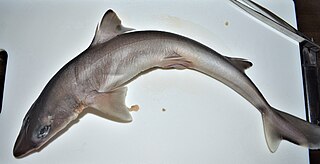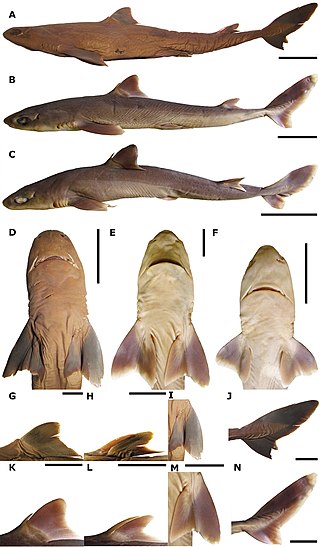Squalidae, more commonly known as dogfish, dog sharks, or spiny dogfish, are one of several families of sharks categorized under Squaliformes, making it the second largest order of sharks, numbering 119 species across 7 families. Having earned their name after a group of fishermen reportedly observed the species chasing down smaller fish in dog-like packs, dogfish have slender, streamlined bodies, usually more compact in comparison to other species, and a pointed snout. Dogfish likewise have two dorsal fins, each with smooth spines, but no anal fin, and their skin is generally rough to the touch. As the species reaches adulthood, males usually measure a maximum of 100 cm, while females typically measure 125 cm long. The species therefore exhibits female-dominant sexual dimorphism.

The spiny dogfish, spurdog, mud shark, or piked dogfish is one of the best known species of the Squalidae (dogfish) family of sharks, which is part of the Squaliformes order.
Squalus is a genus of dogfish sharks in the family Squalidae. Commonly known as spurdogs, these sharks are characterized by smooth dorsal fin spines, teeth in upper and lower jaws similar in size, caudal peduncle with lateral keels; upper precaudal pit usually present, and caudal fin without subterminal notch. In spurdogs, the hyomandibula is oriented at a right angle to the neurocranium, while in other sharks, the hyomandibula runs more parallel to the body. This led some to think that the upper jaw of Squalus would not be as protractile as the jaws of other sharks. However, a study that compared different jaw suspension types in sharks showed that this is not the case and that Squalus is quite capable of protruding its upper jaw during feeding.

The dwarf gulper shark is a dogfish of the family Centrophoridae found in the Indo-West Pacific oceans, from the Gulf of Aden, Japan, Taiwan, and northern Papua New Guinea, living and feeding at dephts exciding 656 ft (m), marine, deep-water dogfish most commonly found between 328 ft and 3937 ft

The Japanese spurdog is a dogfish, a member of the family Squalidae. It is found in the western Pacific Ocean – southeastern Japan and the East China Sea, including the Republic of Korea, the Philippines, and the Arafura Sea. It occurs in temperate and tropical waters along the continental shelf and slopes and primarily feeds on teleost fish and squid. It is caught as bycatch in commercial fishing, which has caused populations to decline.

The shortnose spurdog also known as the piked spurdog is a small shark located primarily off the coast of Southern Australia and South Africa. The shortnose spurdog's size is dependent on the sex of the animal. The female shortnose spurdog is consistently larger than the male shortnose spurdog and will typically measure out to about 56.41 cm (1.85 ft) while the male shortnose spurdog will typically only measure out to about 44.36 cm in length (1.46 ft) which means the female shortnose spurdog is over 10 cm longer than the male shortnose spurdog. Some females can even measure up to 78 cm which is over 2.5 feet long. The life span of spurdog's can be quite long with females typically living longer than males. The average life span of a female shortnose spurdog is 0–29 years old while the male life span is 0-26 though it is estimated that a female can live up to 46 years while a male can only live up to 33. Females also take longer to reach sexual maturity than males and on average are not fertile until they are over 15 years of age. 7 years longer than the 8 years it takes males to reach maturity. The shortnose spurdog's eat a variety of items but primarily favor cephalopods such as squid and octopuses for their meals. Other organisms that have been found in their stomachs include fish, hermit crabs, sponges, brittle stars, the remains of sea lion and even primary producers such as algae.

The blacktailed spurdog is a dogfish, a member of the family Squalidae, found around New Caledonia in the central Pacific Ocean, at depths from 320 to 320 m. Its length is up to 75 cm.

The shortspine spurdog is a dogfish, a member of the family Squalidae, found on continental shelves off Japan in temperate waters, from the surface to 950 m. Its length is up to 75 cm.
Squalus notocaudatus, the bartail spurdog, is a dogfish of the family Squalidae, found on the continental shelf off Queensland, Australia, at depths between 220 and 450 m. The length of the longest specimen measured, an immature male, is 62 cm (24 in). Its reproduction is ovoviviparous .

Squalus albifrons, the eastern highfin spurdog, is a dogfish described in 2007. It is a member of the family Squalidae, found on the continental shelf off Queensland, Australia, at depths between 220 and 510 m. The length of the longest specimen measured is 65 cm (26 in). Its reproduction is ovoviviparous.
Squalus nasutus, the western longnose spurdog, is a dogfish of the family Squalidae, found on the continental shelf off the northwest and southwest coasts of Western Australia, at depths between 300 and 510 m. Its length is at least 55 cm.

The bighead spurdog is a rare and little-known species of dogfish shark in the family Squalidae. It is found in deep water south of New Caledonia, and over the Norfolk Ridge. Reaching at least 90 cm (35 in) in length, this stocky shark is brown above and light below, with a broad head and two dorsal fins with long spines. It is the only member of its genus with both one- and three-pointed dermal denticles. An infrequent bycatch of longline fisheries, this species is listed under Data Deficient by the International Union for Conservation of Nature (IUCN).
Squalus montalbani, the Philippine spurdog or Indonesian greeneye spurdog, is a relatively large species of dogfish shark native to waters off the coast of Australia, the Philippines, and Indonesia. The species was identified in 1912 from a specimen caught off the coast of Luzon Island, and has been both bycatch and a targeted species in fisheries since. Its taxonomy is complex, having been renamed in 1931, being misidentified as a type of shortspine spurdog, then being revived as a species in 2007.
William Toby White is an Australian ichthyologist. He studies speciation and biodiversity of shark, ray, and skate species through morphological and molecular systematics.

The Pacific spiny dogfish is a common species of the Squalidae (dogfish) family of sharks and are among the most abundant species of sharks in the world. This species is closely related to Squalus acanthias and for many years they were treated as a single species. Recent research, using meristic, morphological and molecular data led to the resurrection of the Pacific spiny dogfish as a separate species. The American Fisheries Society recommends the common name "Pacific spiny dogfish" for Squalus suckleyi over alternatives such as "spotted spiny dogfish" and "North Pacific spiny dogfish" and "spiny dogfish" for Squalus acanthias.

The Japanese shortnose spurdog is a dogfish shark in the genus Squalus. It is found from southern Japan to the South China Sea. The length of the longest specimen measured is 60 cm (24 in).
The greeneye spurdog is a species of dogfish described in 2007. It is a member of the family Squalidae, found off the coast of southeastern Australia. The length of the longest specimen measured is 85.6 cm (33.7 in). It was considered conspecific with the shortspine spurdog.
Edmund's spurdog is a dogfish described in 2007. It is a member of the family Squalidae, found off western Australia and Indonesia. The length of the longest specimen measured is 70.0 cm (27.6 in).
Squalus hawaiiensis, the Hawaiian spurdog, is a dogfish, a member of the family Squalidae, found in waters surrounding the Hawaiian Islands, from the surface to 950 m. Its length is up to 75 cm.










